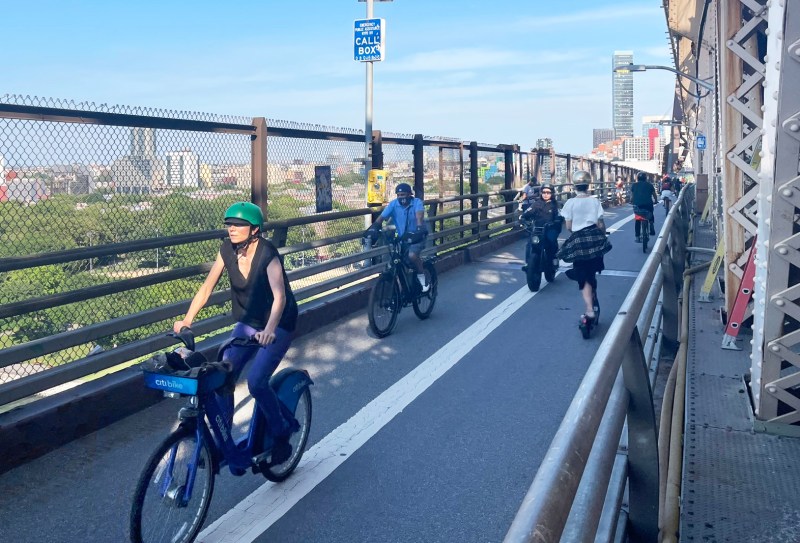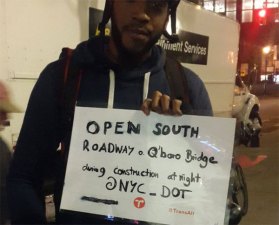Queensboro Bridge Bike Boom Continues, But DOT Still Prioritizes Car Drivers Over Walkers and Cyclists


The bike boom shouldn’t come with a crash.
The city is doubling down on its delay at giving more space to cyclists and pedestrians on the Queensboro Bridge, even as the agency’s own data show that the span had the highest annual increase in bike traffic.
The agency has argued that giving pedestrians what they’ve long been promised — full possession of the bridge’s South Outer Roadway so that walkers would no longer have to share the northernmost lane on the span — would trigger too much congestion for drivers during the ongoing construction on car lanes on the upper deck.
Bicycle trips over the Queensboro Bridge jumped 14 percent this summer compared to the same time last year — but the city still forces cyclists and pedestrians (in both directions) to share one dangerously narrow lane.
Despite those conditions, the Queensboro topped* all other bridges where the DOT counts bike trips, according to a Transportation Alternatives analysis of year-over-year increases this summer versus 2021.
The #bikeboom continues! Comparing Summer 2022 to 2021 ridership:
Prospect Park West -12%
–
Williamsburg Br +0.12%
Manhattan Br +3%
Amsterdam Av at w 86 +6%
Kent Av +6%
Columbus Av at w 86 +8%
SI Ferry +10%
Pulaski Br +13%
Queensboro Br +14%
8th Av at w 50 +38%
Brooklyn Br +102%— Philip Miatkowski (@miatkowski) November 28, 2022
Former Mayor Bill de Blasio originally promised to give the south shoulder roadway to pedestrians and make the northern path bike-only by the end of 2022, but as one of its first moves, the incoming Adams administration’s DOT delayed that until at least late 2023.
The agency said it needs to keep at least seven of the span’s nine car lanes open to lessen driver wait times during a massive rehabilitation — but advocates say the city is putting cyclists and walkers at risk amid repeated crashes and failing to meet the continuing pandemic-era cycling surge.
“The lives and limbs of vulnerable people should come before the convenience of drivers,” said Laura Shepard, a Queens organizer with Transportation Alternatives. “The bike boom is clearly continuing, it’s no surprise there’s a lot more interest in cycling. The bike network in Queens has increased, which has given more people access to safe infrastructure that takes them to the bridge.”
DOT estimates that closing off the southern roadway during the renovations would cause “major traffic delays” in the Manhattan grid.
In a letter to Council Member Julie Won, senior agency officials forecast an additional 8,000 motorists would have to wait to cross over to Queens each weekday — less than 5 percent of the roughly 170,000 vehicles that use the span each business day.
“We are mindful of the increased traffic delays the conversion of the [south outer roadway] to a pedestrian-only path would have,” during the bridge’s upper deck replacement work, wrote Queens Borough Commissioner Nicole Garcia and Manhattan Borough Commissioner Ed Pincar on Oct. 28.
DOT Commissioner Ydanis Rodríguez and fellow agency leaders have refused to budge on the paused redesign, even after Won led them on a walkthrough of the crash-prone bottleneck in September, which the lawmaker at the time described as “talking to a wall.”
Won slammed the agency for prioritizing drivers’s convenience over the safety of pedestrians and cyclists.
“We’ve seen huge increases in both bike ridership and violent crashes on the extremely narrow shared path,” the lawmaker told Streetsblog. “The city must open the south outer roadway immediately for our safety. DOT should stop prioritizing cars over the safety of pedestrians.”
The city has installed more bike infrastructure leading up to the Queens side of the bridge in recent years, such as bike lanes on Skillman and 43rd avenues, 34th Avenue, along with the 39th Avenue bike boulevard, and the 44th Drive bike lanes — and the results show.
DOT logged a whopping 597,366 total trips across the Queensboro during June, July, and August of this year — nearly 6,500 a day — marking a 14-percent increase from 524,397 a year before.
It was second only to the Brooklyn Bridge, where bike trips were up 102 percent this summer compared to the same time last year — but last year’s bike data was depressed because cyclists and pedestrians still shared a single congested walkway before DOT opened a separate bike lane in the roadway in mid-September 2021.
The massive increase on the Brooklyn Bridge makes clear that if you build it they will come, and the continued growth on the Queensboro should push city leaders to get going on revamping that overpass as well, said Transportation Alternatives’s Director of Research Philip Miatkowski, who crunched the DOT stats.
“It’s a number that really just shows what the need is for the Queensboro Bridge,” Miatkowski said.
He noted that the Brooklyn Bridge increases didn’t lead to a drop off in trips over the nearby Manhattan Bridge, up 3 percent, or the Williamsburg Bridge, up 0.12%.
The smaller Pulaski Bridge between north Brooklyn and Queens also had a big bump of 13 percent. DOT repurposed a car lane for cyclists on that span back in 2016.
“We’re seeing all the bridge counts up, so it’s not like people are changing their routes and it’s depleting from the other bridges,” Miatkowski said.
For now, the DOT says it “remains committed to expanding cycling and pedestrian space” on the Queensboro Bridge, but spokesman Tomas Garita confirmed that the much needed project is not being expedited because of the needs of drivers.
“[We] need to complete the bridge’s absolutely critical deck replacement project,” Garita said.
*The Brooklyn Bridge did have a bigger percentage increase between Summer 2021 and Summer 2022 at 102 percent, but that data compares trips on two different bike lanes, the old one that was shared with pedestrians on the boardwalk and the separated path DOT installed on the roadway in mid-September 2021.

